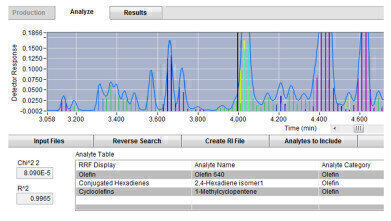-
 Figure 1: A time slice in the VUV Analyze™ post-run analysis window that highlights the deconvolution of an olefin, conjugated hexadiene, and cycloolefin. VUV Analyze™ reports olefin subcategories along with total olefin mass %.
Figure 1: A time slice in the VUV Analyze™ post-run analysis window that highlights the deconvolution of an olefin, conjugated hexadiene, and cycloolefin. VUV Analyze™ reports olefin subcategories along with total olefin mass %.
Analytical Instrumentation
VUV PIONA+™ Automates the Analysis of Olefin Classes in Fuel Stream Samples
Jun 04 2018
VUV Analytics, Inc. (Austin, TX) has expanded the olefin compound classes that can be characterised in gasoline range samples by VUV PIONA+™ via ASTM D8071 to include non-conjugated diolefins, conjugated diolefins, cycloolefins, and conjugated hexadienes. After an initial setup step in VUV Analyze™ data processing software, these olefin sub-categories can be added to the automated post-run report along with total amounts of paraffin, isoparaffin, olefin, naphthene, and aromatic (PIONA) hydrocarbon classes. VUV Analyze™ also allows further customization of the report to include specific analyte speciation and other sub-classes such as di-aromatics.
Olefins, especially conjugated diolefins, are known to cause fouling of refinery processes and to negatively impact product quality. Conjugated diolefins are monitored in fluid catalytic cracking (FCC) gasolines because they are highly reactive to polymerisation and plug downstream refining processes. Legacy methods for conjugated diene characterization vary in their respective levels of complexity, analysis time, and accuracy. For example, UOP-326 (maleic anhydride method) takes more than 3 hours to complete, does not completely react with some conjugated dienes, can be interfered with by alcohols, and is difficult to automate. In contrast, ASTM D8071 applies to all finished gasoline samples, has successfully been used for other gasoline-range sample types, has a GC run time of approximately 30 minutes, and includes the automated analysis of relative PIONA hydrocarbon totals.
ASTM D8071 uses straightforward instrumentation: a gas chromatograph, a standard 30m nonpolar column, and a VUV detector. The method provides complete PIONA compound class characterization in a single measurement. It utilizes the similarity of VUV spectra within compound classes to determine group composition within a sample, while also using unique VUV spectra to speciate individual analytes such as ethanol, iso-octane, benzene, toluene, ethylbenzene, xylenes, naphthalene, and methylnaphthalene compounds. ASTM D8071 is also enabled by the ability of VUV Analyze™ to deconvolve co-eluting species and provide accurate determination of relative hydrocarbon group concentrations in mass or volume percent.
VUV Analyze™ software implements equations and fit procedures that result in the deconvolution of absorbance spectra that contain contributions from multiple species. It is capable of binning and storing response contributions from each deconvolution analysis and reporting a combined total response at the end of the analysis. Its data processing includes a database library of reference spectra, compound class information, density, approximate retention index values, relative response factors for each hydrocarbon class, and relative response factors for individually reported compounds.
The customisation of VUV PIONA+™ for olefin sub-categories was recently demonstrated on a gasoline range sample with high olefin concentration. ASTM D8071 was applied to this sample, and VUV Analyze™ reported 37% total olefin concentration that included 0.2% non-conjugated diolefins, 0.3% conjugated diolefins, 4.5% cycloolefins, and 0.1% conjugated hexadienes. Olefins that do not belong to these sub-categories such as trans-2-heptene were accounted for in the remaining 31.9% reported as total olefin %. Figure 1 shows a time slice in the VUV Analyze™ post-run analysis window that highlights the deconvolution of an olefin, conjugated hexadiene, and cycloolefin. Another recent investigation used this sub-category characterisation capability to determine the non-conjugated diolefin, conjugated diolefin, and cycloolefins content of coker naphtha samples. VUV PIONA+™ via ASTM D8071 is an effective method for monitoring the occurrence of problematic olefins and informing fuel blending decisions during refining processes.
For more detailed information please visit our website at www.vuvanalytics.com, or contact us at info@vuvanalytics.com.
Digital Edition
PIN 25.1 Feb/March
March 2024
In This Edition Safety - The technology behind the ION Science Tiger XT - Safety with ammonia and LOHCs as hydrogen carriers Analytical Instrumentation - Discussion on new tribology te...
View all digital editions
Events
Apr 28 2024 Montreal, Quebec, Canada
Apr 30 2024 Birmingham, UK
May 03 2024 Seoul, South Korea
May 05 2024 Seville, Spain
May 06 2024 Riyadh, Saudi Arabia

















